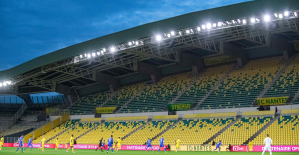It was in the year 9 AD. In today's Haltern am See, located in the North Rhine-Westphalian district of Recklinghausen, the Roman general Varus sets out with the 19th legion towards the Weser. A short time later he was caught in a Germanic ambush in the "saltus Teutoburgiensis" in the Teutoburg Forest. This is how Roman historians put it. Varus is killed, his troops destroyed. After that, the Romans gave up their goal of establishing a province of Germania on the right bank of the Rhine. The Varus Battle will go down in school books as a turning point in history.
There are hundreds of theories about exactly where this battle was fought. Most of the time they suspect the place to be in the area that we now call the Teutoburg Forest. But for several years it has become apparent that Varus has found its end further north at Kalkriese in the Osnabrücker Land. An ancient battlefield has been excavated and researched there since the 1980s. There are many indications that these are the remnants of the armed conflict of the year 9. Recently there has been evidence of this. A few weeks ago, Annika Diekmann, who works at the Bochum Mining Museum, published her doctoral thesis.
She examined metal remains from belt buckles, horse harness and the like for their chemical composition, created a so-called metallurgical fingerprint of the Kalkriese finds - and compared this with the metal finds from the Roman camps in Haltern and in Dangstetten in Baden-Württemberg. The 19th Legion was demonstrably stationed at these two locations. Lo and behold: the composition of the material is identical. From this, the researchers conclude that Kalkriese's devastated army must have been the 19th Legion of General Varus.
For Bettina Tremmel, an expert in Roman archeology at the Regional Association of Westphalia-Lippe, this raises new questions. She is not only interested in the location of the Varus Battle, she rather tries to reconstruct the exact sequence of Roman activities on the right bank of the Rhine. In addition to Haltern, logistics also included other warehouses in Westphalia, she explains. Some of them have been found - for example in Anreppen near Delbrück in the Paderborn district, in Oberaden near Bergkamen, in Beckinghausen near Lünen or in Olfen in the Coesfeld district. They are assigned to earlier phases, when the generals Drusus and Tiberius carried out the military operations in Germania with the 17th and 18th legions.
Tremmel would now also like to have the finds from these Westphalian camps examined using the new method. If the theory is correct that a metallurgical fingerprint can be assigned to a certain legion, then, according to Tremmel, one should be able to distinguish the Westphalian camps from one another. "But if the same metallurgical fingerprint were also found in other Roman camps such as Anreppen or Oberaden, something doesn't fit our picture: Varus cannot have been in these camps at the same time as in Haltern and Dangstetten," says the researcher. “Or the chronological sequence was different than previously thought. When was Varus where? Easy question, hard answer. The detective game is not over yet.”

 Iran-Israel conflict: what we know about the events of the night after the explosions in Isfahan
Iran-Israel conflict: what we know about the events of the night after the explosions in Isfahan Sydney: Assyrian bishop stabbed, conservative TikToker outspoken on Islam
Sydney: Assyrian bishop stabbed, conservative TikToker outspoken on Islam Torrential rains in Dubai: “The event is so intense that we cannot find analogues in our databases”
Torrential rains in Dubai: “The event is so intense that we cannot find analogues in our databases” Rishi Sunak wants a tobacco-free UK
Rishi Sunak wants a tobacco-free UK Alert on the return of whooping cough, a dangerous respiratory infection for babies
Alert on the return of whooping cough, a dangerous respiratory infection for babies Can relaxation, sophrology and meditation help with insomnia?
Can relaxation, sophrology and meditation help with insomnia? WHO concerned about spread of H5N1 avian flu to new species, including humans
WHO concerned about spread of H5N1 avian flu to new species, including humans New generation mosquito nets prove much more effective against malaria
New generation mosquito nets prove much more effective against malaria The A13 motorway closed in both directions for an “indefinite period” between Paris and Normandy
The A13 motorway closed in both directions for an “indefinite period” between Paris and Normandy The commitment to reduce taxes of 2 billion euros for households “will be kept”, assures Gabriel Attal
The commitment to reduce taxes of 2 billion euros for households “will be kept”, assures Gabriel Attal Unemployment insurance: Gabriel Attal leans more towards a tightening of affiliation conditions
Unemployment insurance: Gabriel Attal leans more towards a tightening of affiliation conditions “Shrinkflation”: soon posters on shelves to alert consumers
“Shrinkflation”: soon posters on shelves to alert consumers The restored first part of Abel Gance's Napoléon presented at Cannes Classics
The restored first part of Abel Gance's Napoléon presented at Cannes Classics Sting and Deep Purple once again on the bill at the next Montreux Jazz Festival
Sting and Deep Purple once again on the bill at the next Montreux Jazz Festival Rachida Dati: one hundred days of Culture on the credo of anti-elitism
Rachida Dati: one hundred days of Culture on the credo of anti-elitism The unbearable wait for Marlène Schiappa’s next masterpiece
The unbearable wait for Marlène Schiappa’s next masterpiece Skoda Kodiaq 2024: a 'beast' plug-in hybrid SUV
Skoda Kodiaq 2024: a 'beast' plug-in hybrid SUV Tesla launches a new Model Y with 600 km of autonomy at a "more accessible price"
Tesla launches a new Model Y with 600 km of autonomy at a "more accessible price" The 10 best-selling cars in March 2024 in Spain: sales fall due to Easter
The 10 best-selling cars in March 2024 in Spain: sales fall due to Easter A private jet company buys more than 100 flying cars
A private jet company buys more than 100 flying cars This is how housing prices have changed in Spain in the last decade
This is how housing prices have changed in Spain in the last decade The home mortgage firm drops 10% in January and interest soars to 3.46%
The home mortgage firm drops 10% in January and interest soars to 3.46% The jewel of the Rocío de Nagüeles urbanization: a dream villa in Marbella
The jewel of the Rocío de Nagüeles urbanization: a dream villa in Marbella Rental prices grow by 7.3% in February: where does it go up and where does it go down?
Rental prices grow by 7.3% in February: where does it go up and where does it go down? With the promise of a “real burst of authority”, Gabriel Attal provokes the ire of the opposition
With the promise of a “real burst of authority”, Gabriel Attal provokes the ire of the opposition Europeans: the schedule of debates to follow between now and June 9
Europeans: the schedule of debates to follow between now and June 9 Europeans: “In France, there is a left and there is a right,” assures Bellamy
Europeans: “In France, there is a left and there is a right,” assures Bellamy During the night of the economy, the right points out the budgetary flaws of the macronie
During the night of the economy, the right points out the budgetary flaws of the macronie These French cities that will boycott the World Cup in Qatar
These French cities that will boycott the World Cup in Qatar Champions League: France out of the race for 5th qualifying place
Champions League: France out of the race for 5th qualifying place Ligue 1: at what time and on which channel to watch Nantes-Rennes?
Ligue 1: at what time and on which channel to watch Nantes-Rennes? Marseille-Benfica: 2.99 million viewers watching OM’s victory on M6
Marseille-Benfica: 2.99 million viewers watching OM’s victory on M6 Cycling: Cofidis continues its professional adventure until 2028
Cycling: Cofidis continues its professional adventure until 2028


















